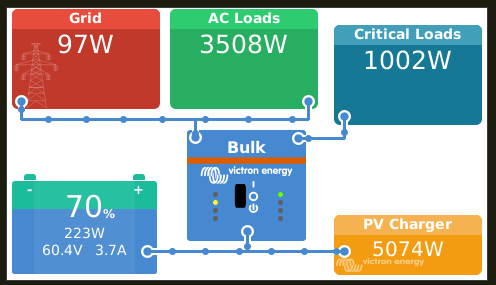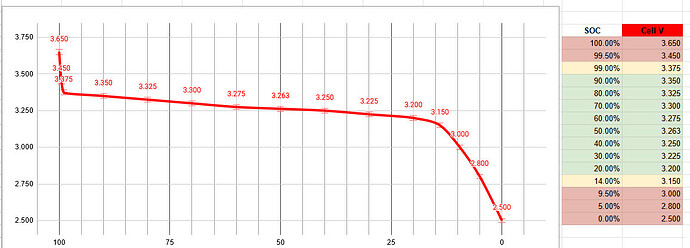Any comment?
Are we talking about cell phone batts or solar system batts?
The article seems to focus on cellphone/laptop batts, which do not like to be:
- kept at 100% charge
- High temps are very bad
- ideal to keep on the lithium plateau.
Lifepo4 same …
OK… so what is one to do? My system is usually charged by midday, then the battery sits at 100% until maybe 5 in the PM, then starts discharging until PV starts coming online the next morning - around 7 this time of year.
It has to get to 100% sometime because that’s when all the cell balancing takes place. But would it be kind to my batteries to try to devise some sort of strategy that lets them kiss 100% briefly once day?
PS it seldom gets discharged past 50%.
Well, often the best thing to do is just stop worrying about it.
A massive amount of battery parameters are actually CHOSEN by the guy who designs them. You can always build a battery that lasts longer by adding more capacity and hiding it in software, then releasing it slowly over time, by using a lower EOL figure, or by picking a lower voltage for 100% SOC.
The designer decides what 100% means. It doesn’t mean the same thing for every battery. In a battery where 100% is already designed to be at a lower voltage, you may not have to stress about this at all.
To use the battery of the BMW i3 as an example: It is a 22kWh battery, of whith 18.8kWh is usable. That is, they only use 90% of the capacity, they have 5% at the bottom and 5% at the top which they reserve. That means that when the battery is 100% full… it is only really 95% full. When it is completely empty, it still has 5% left in it.
A BSL battery for example, with 16 cells (so properly full at 58V) is considered full by its designer at 54.5V. There is a reason they did that, and for that same reason, you don’t have to worry about not charging to 100%. It is already not charging to “100%”.
Because of the flat voltage curve of LiFePO4, you don’t have a lot of choice here, your cells will get to pretty much 100% at 3.4V/cell. If you go lower, they will drift quite quickly due to the flat voltage curve. Luckily, they don’t have the same degree of accelerated deterioration that other Li-Ion chemistries have in this state, so don’t bother with it.
With LiFePO4 odds are that the cells fail because the BMS failed at some point with no indication (like balancing resistors etc). Which is why almost all the warranties are worded the way they are. So there really is no point in trying to extend cell life…
Hence so “quickly” charged?
Mine seldom does not get discharged to 20%.
Maybe if I see the weather and 8 am LS, I will remember to up the min SOC to like 30%.
They are charged by 4pm-ish … geysers, plural, also heated. House powered the whole day.
And as other have said, stop worrying, bar the 50%. ![]()
Don’t let your batts die of “old age” in 15-20 years, having been “lightly used”.
Edit:
They where at ±20% 8 am this morning… geyser is being heated, and they will get to 100% SOC by 4ish, if the weather stays cool with some high clouds.

Just some insight: Each manufacturer does its own thing.
100% SOC for me is at 3.45v.
Balancing starts at 3.45v.
It works beautifully.
Once the system has hit ±3.48v, always a bit of overshooting, the balancer does its thing, and volts settle on 3.45v.
Then the system goes to float. Batt is “softly” discharged down to 3.375v, charge a bit, discharge a bit, over and over, down to the float volts. SOC is still 100%, the coulomb counting.
BMV is my SOC, BMS is just there to do the balancing and protection. I have no link between BMS and Venus, Victron does it all pretty nicely, thank you.
Indeed, with LFP you don’t have much choice anyway. I heard somewhere that you’re at around 98% once you reach 3.4V per cell, and for the balancer to work you must get up there at least once a week.
Sometimes the battery maker will want to squeeze out that extra 2%, and sometimes not. They redraw the SOC scale to run from -2% to 102% and chop off the ends. In that case, you may not have to do anything.
Edit: In fact, I seem to recall an engineer from one of the battery makers – a 15 cell model – saying that at 54V they consider it 102% full. Of course they don’t display that on the screen… that will just cause too many questions ![]()
